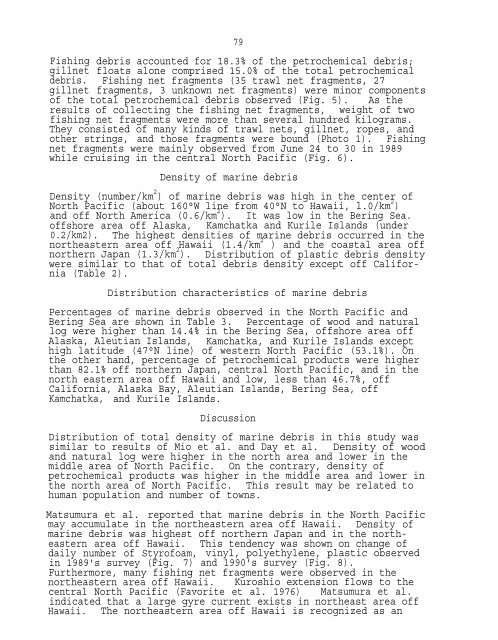Poster abstracts and manuscripts from the Third International ...
Poster abstracts and manuscripts from the Third International ...
Poster abstracts and manuscripts from the Third International ...
You also want an ePaper? Increase the reach of your titles
YUMPU automatically turns print PDFs into web optimized ePapers that Google loves.
Fishing debris accounted for 18.3% of <strong>the</strong> petrochemical debris;<br />
gillnet floats alone comprised 15.0% of <strong>the</strong> total petrochemical<br />
debris. Fishing net fragments (35 trawl net fragments, 27<br />
gillnet<br />
of <strong>the</strong> total petrochemical debris observed (Fig. 5).<br />
fragments, 3 unknown net fragments) were minor components<br />
As <strong>the</strong><br />
results of collecting <strong>the</strong> fishing net fragments, weight of two<br />
fishing net fragments were more than several hundred kilograms.<br />
They consisted of many kinds of trawl nets, gillnet, ropes, <strong>and</strong><br />
o<strong>the</strong>r strings, <strong>and</strong> those fragments were bound (Photo 1).<br />
net fragments were mainly observed <strong>from</strong> June 24 to 30 in 1989<br />
while cruising in <strong>the</strong> central North Pacific (Fig. 6).<br />
79<br />
Density of marine debris<br />
Fishing<br />
Density (number/km 2 ) of marine debris was high in <strong>the</strong> center of<br />
North Pacific (about 160°W line <strong>from</strong> 40°N to Hawaii, l.0/km 2 )<br />
<strong>and</strong> off North America (0.6/km 2 ). It was low in <strong>the</strong> Bering Sea.<br />
offshore area off Alaska, Kamchatka <strong>and</strong> Kurile Isl<strong>and</strong>s (under<br />
0.2/km2). The highest densities of marine debris occurred in <strong>the</strong><br />
nor<strong>the</strong>astern area off Hawaii (1.4/km 2 ) <strong>and</strong> <strong>the</strong> coastal area off<br />
nor<strong>the</strong>rn Japan (1.3/km 2 ). Distribution of plastic debris density<br />
were similar to that of total debris density except off California<br />
(Table 2).<br />
Distribution characteristics of marine debris<br />
Percentages of marine debris observed in <strong>the</strong> North Pacific <strong>and</strong><br />
Bering Sea are shown in Table 3. Percentage of wood <strong>and</strong> natural<br />
log were higher than 14.4% in <strong>the</strong> Bering Sea, offshore area off<br />
Alaska, Aleutian Isl<strong>and</strong>s, Kamchatka, <strong>and</strong> Kurile Isl<strong>and</strong>s except<br />
high latitude (47°N line) of western North Pacific (53.1%). On<br />
<strong>the</strong> o<strong>the</strong>r h<strong>and</strong>, percentage of petrochemical products were higher<br />
than 82.1% off nor<strong>the</strong>rn Japan, central North Pacific, <strong>and</strong> in <strong>the</strong><br />
north eastern area off Hawaii <strong>and</strong> low, less than 46.7%, off<br />
California, Alaska Bay, Aleutian Isl<strong>and</strong>s, Bering Sea, off<br />
Kamchatka, <strong>and</strong> Kurile Isl<strong>and</strong>s.<br />
Discussion<br />
Distribution of total density of marine debris in this study was<br />
similar to results of Mio et al. <strong>and</strong> Day et al. Density of wood<br />
<strong>and</strong> natural log were higher in <strong>the</strong> north area <strong>and</strong> lower in <strong>the</strong><br />
middle area of North Pacific. On <strong>the</strong> contrary, density of<br />
petrochemical products was higher in <strong>the</strong> middle area <strong>and</strong> lower in<br />
<strong>the</strong> north area of North Pacific. This result may be related to<br />
human population <strong>and</strong> number of towns.<br />
Matsumura et al. reported that marine debris in <strong>the</strong> North Pacific<br />
may accumulate in <strong>the</strong> nor<strong>the</strong>astern area off Hawaii. Density of<br />
marine debris was highest off nor<strong>the</strong>rn Japan <strong>and</strong> in <strong>the</strong> nor<strong>the</strong>astern<br />
area off Hawaii. This tendency was shown on change of<br />
daily number of Styrofoam, vinyl, polyethylene, plastic observed<br />
in 1989's survey (Fig. 7) <strong>and</strong> 1990's survey (Fig. 8).<br />
Fur<strong>the</strong>rmore, many fishing net fragments were observed in <strong>the</strong><br />
nor<strong>the</strong>astern area off Hawaii. Kuroshio extension flows to <strong>the</strong><br />
central North Pacific (Favorite et al. 1976) Matsumura et al.<br />
indicated that a large gyre current exists in nor<strong>the</strong>ast area off<br />
Hawaii. The nor<strong>the</strong>astern area off Hawaii is recognized as an
















